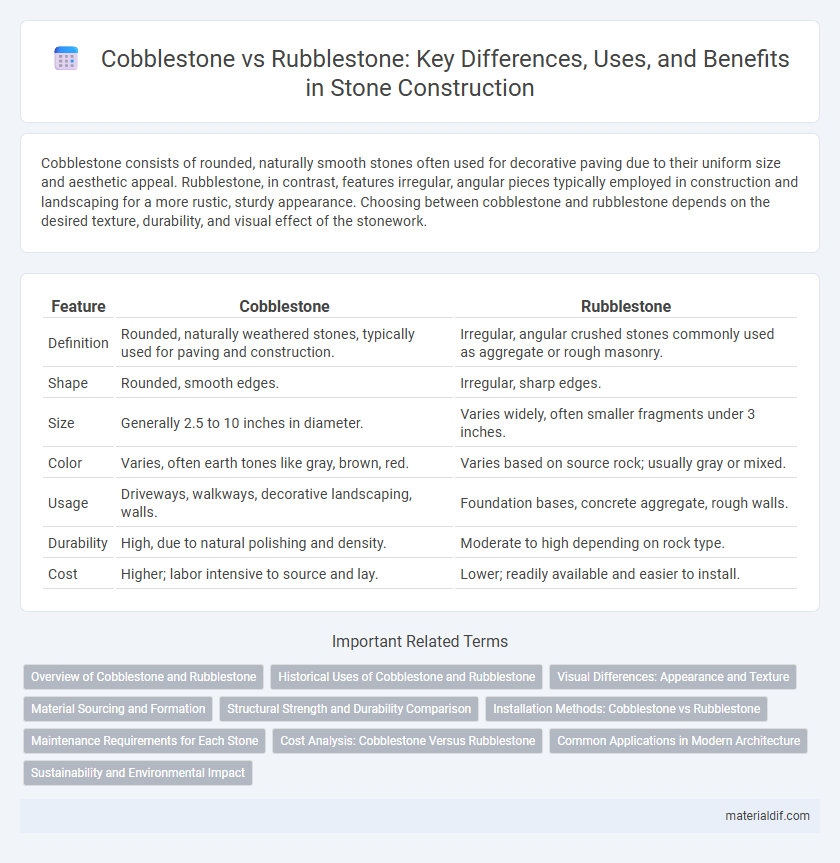Cobblestone consists of rounded, naturally smooth stones often used for decorative paving due to their uniform size and aesthetic appeal. Rubblestone, in contrast, features irregular, angular pieces typically employed in construction and landscaping for a more rustic, sturdy appearance. Choosing between cobblestone and rubblestone depends on the desired texture, durability, and visual effect of the stonework.
Table of Comparison
| Feature | Cobblestone | Rubblestone |
|---|---|---|
| Definition | Rounded, naturally weathered stones, typically used for paving and construction. | Irregular, angular crushed stones commonly used as aggregate or rough masonry. |
| Shape | Rounded, smooth edges. | Irregular, sharp edges. |
| Size | Generally 2.5 to 10 inches in diameter. | Varies widely, often smaller fragments under 3 inches. |
| Color | Varies, often earth tones like gray, brown, red. | Varies based on source rock; usually gray or mixed. |
| Usage | Driveways, walkways, decorative landscaping, walls. | Foundation bases, concrete aggregate, rough walls. |
| Durability | High, due to natural polishing and density. | Moderate to high depending on rock type. |
| Cost | Higher; labor intensive to source and lay. | Lower; readily available and easier to install. |
Overview of Cobblestone and Rubblestone
Cobblestone consists of naturally rounded stones, typically used for paving streets, paths, and decorative walls due to its smooth texture and uniform size. Rubblestone refers to irregularly shaped, rough stones often utilized in construction for foundations, retaining walls, and rustic architectural features because of its versatility and natural appearance. Both materials offer durability and aesthetic appeal but differ significantly in shape, finish, and common applications.
Historical Uses of Cobblestone and Rubblestone
Cobblestone has historically been utilized for paving streets and walkways due to its rounded shape and durability, commonly seen in European towns dating back to the Roman era. Rubblestone, characterized by irregular shapes and rough texture, was primarily used in foundational structures and rustic walls in medieval architecture. Both materials reflect distinct architectural practices, with cobblestone favoring smooth, stable surfaces and rubblestone emphasizing structural strength in construction.
Visual Differences: Appearance and Texture
Cobblestone features smooth, rounded surfaces with uniform shapes, creating a polished and orderly appearance ideal for pathways and decorative landscaping. Rubblestone consists of irregular, rough-textured pieces with uneven edges, offering a rustic and rugged look commonly used in wall facades and foundations. The distinct visual differences in shape and texture of cobblestone versus rubblestone define their applications and aesthetic appeal in construction and design.
Material Sourcing and Formation
Cobblestone is sourced from naturally rounded river or beach stones formed through prolonged water erosion and sediment transport, resulting in smooth, uniform surfaces ideal for paving. Rubblestone consists of irregular, angular fragments obtained from quarried bedrock, typically granite or limestone, reflecting minimal natural weathering and retaining rough textures suited for structural masonry. These distinct sourcing methods influence the stone's durability, appearance, and suitability for specific architectural applications.
Structural Strength and Durability Comparison
Cobblestone offers higher structural strength due to its uniform, rounded shape, allowing for tight fitting and greater load distribution in masonry. Rubblestone, characterized by irregular and angular fragments, provides less consistent strength but excels in durability through its ability to absorb and dissipate stress over time. Both materials are durable; however, cobblestone structures typically demonstrate superior resistance to compression and wear, making them preferable for high-load applications.
Installation Methods: Cobblestone vs Rubblestone
Cobblestone installation involves precise placement of uniformly shaped stones set on a compacted sand or mortar base, ensuring a smooth, even surface ideal for driveways and walkways. Rubblestone installation requires fitting irregularly shaped stones into a solid mortar matrix, creating a rustic, robust structure frequently used in retaining walls and facades. Both methods demand proper base preparation and drainage considerations to ensure longevity and stability of the masonry work.
Maintenance Requirements for Each Stone
Cobblestone requires regular maintenance due to its rounded surface, which can accumulate dirt and moss, necessitating frequent cleaning and occasional re-pointing of the joints to prevent weed growth. Rubblestone, with its irregular shapes and rough texture, tends to trap debris and moisture, demanding thorough cleaning and sealing to avoid deterioration and structural damage over time. Both materials benefit from periodic inspections to address any loose stones or mortar deterioration, ensuring longevity and aesthetic appeal.
Cost Analysis: Cobblestone Versus Rubblestone
Cobblestone typically incurs higher costs due to its uniform shape and the labor-intensive installation process, making it ideal for decorative paving and pathways. Rubblestone, being irregular and more abundant, offers a cost-effective alternative suited for structural applications like retaining walls and foundations. Evaluating project requirements and budget constraints helps determine the best stone choice for both aesthetics and affordability.
Common Applications in Modern Architecture
Cobblestone is frequently used in modern architecture for decorative paving, walkways, and driveways due to its rounded texture and durability, which provide a classic aesthetic appeal. Rubblestone finds common applications in retaining walls, foundations, and rustic facade cladding because of its irregular shapes and cost-effectiveness in load-bearing structures. Both materials contribute to sustainable construction by utilizing natural stone elements that blend with contemporary design trends.
Sustainability and Environmental Impact
Cobblestone is a natural, durable material often sourced locally, reducing transportation emissions and promoting sustainability through minimal processing. Rubblestone, consisting of irregular, uncut stones, typically requires less energy-intensive fabrication, lowering its environmental footprint compared to highly processed stones. Both types support sustainable construction by offering long-lasting, recyclable materials that contribute to reduced waste and resource conservation in building projects.
Cobblestone vs Rubblestone Infographic

 materialdif.com
materialdif.com